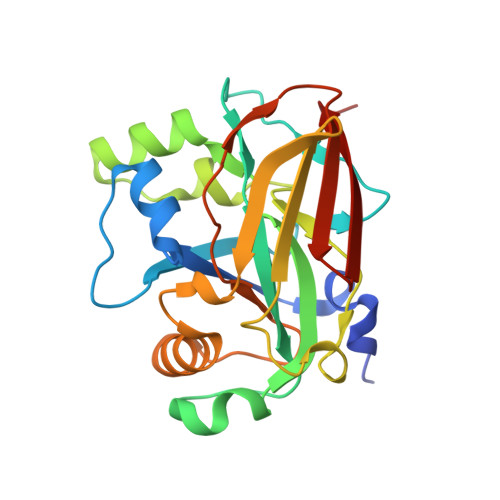Structural basis for the bi-functionality of human oxaloacetate decarboxylase FAHD1.
Weiss, A.K.H., Naschberger, A., Loeffler, J.R., Gstach, H., Bowler, M.W., Holzknecht, M., Cappuccio, E., Pittl, A., Etemad, S., Dunzendorfer-Matt, T., Scheffzek, K., Liedl, K.R., Jansen-Durr, P.(2018) Biochem J 475: 3561-3576
- PubMed: 30348641
- DOI: https://doi.org/10.1042/BCJ20180750
- Primary Citation of Related Structures:
6FOG, 6FOH - PubMed Abstract:
Whereas enzymes in the fumarylacetoacetate hydrolase (FAH) superfamily catalyze several distinct chemical reactions, the structural basis for their multi-functionality remains elusive. As a well-studied example, human FAH domain-containing protein 1 (FAHD1) is a mitochondrial protein displaying both acylpyruvate hydrolase (ApH) and oxaloacetate decarboxylase (ODx) activity. As mitochondrial ODx, FAHD1 acts antagonistically to pyruvate carboxylase, a key metabolic enzyme. Despite its importance for mitochondrial function, very little is known about the catalytic mechanisms underlying FAHD1 enzymatic activities, and the architecture of its ligated active site is currently ill defined. We present crystallographic data of human FAHD1 that provide new insights into the structure of the catalytic center at high resolution, featuring a flexible 'lid'-like helical region which folds into a helical structure upon binding of the ODx inhibitor oxalate. The oxalate-driven structural transition results in the generation of a potential catalytic triad consisting of E33, H30 and an associated water molecule. In silico docking studies indicate that the substrate is further stabilized by a complex hydrogen-bond network, involving amino acids Q109 and K123, identified herein as potential key residues for FAHD1 catalytic activity. Mutation of amino acids H30, E33 and K123 each had discernible influence on the ApH and/or ODx activity of FAHD1, suggesting distinct catalytic mechanisms for both activities. The structural analysis presented here provides a defined structural map of the active site of FAHD1 and contributes to a better understanding of the FAH superfamily of enzymes.
- Research Institute for Biomedical Aging Research, University of Innsbruck, Rennweg 10, Innsbruck A-6020, Austria.
Organizational Affiliation:



















